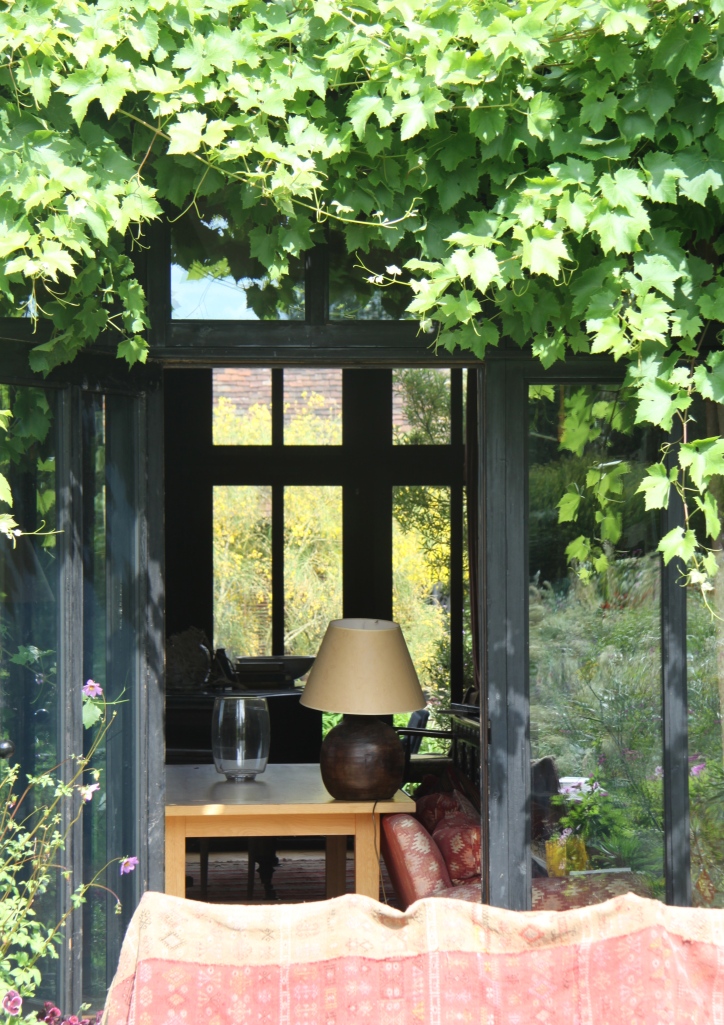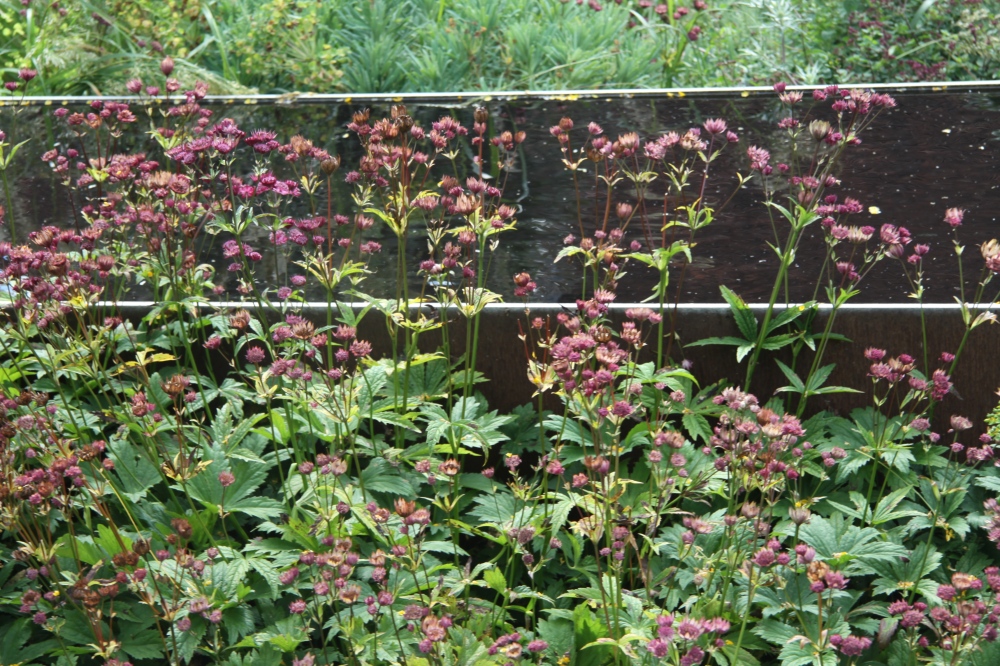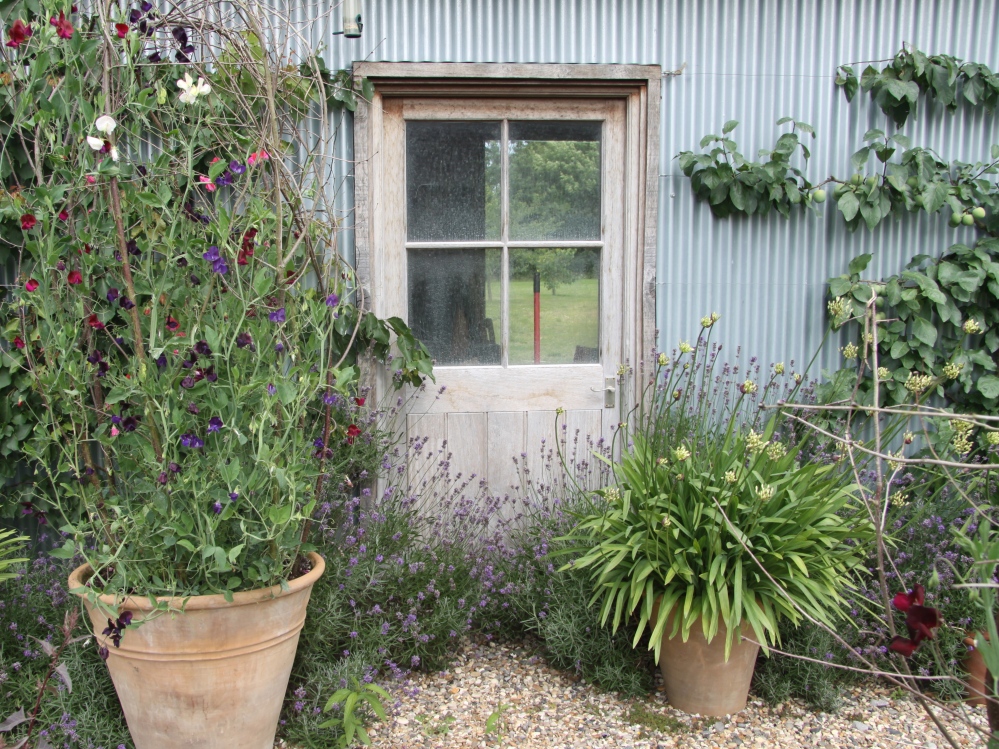TOM STUART-SMITH’S VIBRANT, SCENTED JULY GARDEN (AND THE CAKE TO MATCH IT)  The Sunken courtyard garden, Serge Hill with brilliant yellow Mount Etna Broom billowing overhead and a soft tapestry of grasses, salvia, astrantia and Euphorbia at ground level
The Sunken courtyard garden, Serge Hill with brilliant yellow Mount Etna Broom billowing overhead and a soft tapestry of grasses, salvia, astrantia and Euphorbia at ground level
The problem Tom Stuart-Smith must face when he occasionally opens his Hertfordshire garden is that none of the visitors are inclined to leave. It is a glorious Monday in July and only a few miles north of the clutter and bustle of the Edgware Road. I step out of my car and am immediately met with this: idyllic, gently rolling parkland – blond grass and spreading oaks, the view softened by perfectly judged swathes of uncut meadow that divide the house from the countryside beyond:
The view from Serge Hill
Sweetly clad outbuildings begin the sense of welcome and tip you, deliciously unsuspecting, into the different garden spaces beyond. 
Outbuildings festooned with clematis and roses
Turning right, my breath is taken away by stretches of pale, delicate Echinacea pallida which float freely like exquisite jelly fish in the Prairie.
Echinacea Pallida
In this gorgeous area of of prairie planting Tom has created a dreamy place to experiment with broad sweeps of colour and form: as each plant comes into its own it casts a certain new intensity or contrast of texture on the scene. Here, fantastically generous quantities of Dianthus carthusianorum add both an earthy density and an almost luminous glow to the softly pastel, slightly shredded quality of the Echinacea.
Dianthus carthusianorum and Echinacea pallida
The wonderful coral red Penstemmon barbatus coccineus is scattered gently through the planting to lift it away from the coolness of the pinks:
Coral red Penstemmon barbatus coccineus amongst Echinacea and Dianthus carthusianorum
And there are – almost hidden – dashes of a really wild orange from the native American milkweed, Asclepias tuberose
Asclepias tuberose with Dianthus carthusianorum
The whole scene is naturally masterfully framed – here by handsome hedges and rusty roof tiles:
Here by the simple pale blue-grey of the corrugated iron building designed by Ptolemy Dean: The towering forms of Silphium laciniatum – another native American prairie plant, the Compass plant – seem to herald a leitmotive throughout the garden, as if Tom Stuart-Smith is keen to ensure that there are tall elegant shadows of his tall elegant self just in case he is not personally there to greet you.
The towering forms of Silphium laciniatum – another native American prairie plant, the Compass plant – seem to herald a leitmotive throughout the garden, as if Tom Stuart-Smith is keen to ensure that there are tall elegant shadows of his tall elegant self just in case he is not personally there to greet you.
Silphium laciniatum against the sky
Through a simple oak gate into a classic, scented kitchen garden:
It is at this point that the visitors – who are here to support the NGS and The Garden Museum – begin to find the whole thing highly covetable and start to put down their own roots. The Prairie has been a surprising and ethereal adventure but here, there is a manageable, settled feel with that brilliant combination of productive order and sense of overspilling colour that you get from the happiest kitchen gardens:
Verbena bonariensis and Allium sphaerocephalon amongst beans in the kitchen garden View through to the Pelargonium and tomato-filled greenhouse
View through to the Pelargonium and tomato-filled greenhouse
The blue-grey corrugated iron and bleached wooden door of the kitchen garden ‘shed’ a subtle backdrop to pots of scented sweet peas, white agapanthus, espaliered fruit trees and lavender.
Tulbaghia violacea a brilliantly perky edging to a bed of moody blue-green cabbage
Back out of the kitchen garden and into the calm of meadow and hedge:
A further rounded, shaggy yew hedge forms a protective embrace around the main family garden:
Beyond the hedge I find myself in a rich terracotta, green and fading mauve haven of comfort and softness. This a National Garden Scheme version of the Marie Celeste – the table and chairs are set out and ready to go, an embroidered cinnamon coloured shawl is draped casually over a bench the doors to the house are breezily ajar. But there are no Stuart-Smiths about and again the visitors find themselves settling down at the table, moving on only with difficulty: Through the barn windows framed by a voluptuous draped vine, there is an intoxicating glimpse of rich yellow from the Mount Etna Broom beyond:
Through the barn windows framed by a voluptuous draped vine, there is an intoxicating glimpse of rich yellow from the Mount Etna Broom beyond: Palest yellow hollyhocks provide a serene offbeat echo to the riot of yellow through the archway:
Palest yellow hollyhocks provide a serene offbeat echo to the riot of yellow through the archway:
As you pull away from the house you reach a potentially formal area of clipped box hedges and sky-scratching yew columns (that Tom Stuart-Smith leitmotiv again) but in fact the topiary shapes serve more as a happy, forgiving foil to overspilling herbaceous planting.
 The topiary shapes are used as a happy, forgiving foil to overspilling herbacious planting:
The topiary shapes are used as a happy, forgiving foil to overspilling herbacious planting: Stately white Epilobium dances in the space between the yew columns
Stately white Epilobium dances in the space between the yew columns
 Stipa gigantea and Phlomis russeliana catch the light
Stipa gigantea and Phlomis russeliana catch the light
There is a moment of elegant calm with neatly clipped hedges and a troupe of slender, lacy poplars (the need for something tall and slim again):
Poplars and clipped hedges agains the sky
And then the chance to meander along gently shaded wooded areas: 
The planting combinations are simple, and always brilliantly thoughtful – here a blue geranium is illuminated by the tiny rice like flowers of the arching grass, Mellica altissima ‘Alba’ :
 Melica altissima ‘Alba’ and a blue geranium
Melica altissima ‘Alba’ and a blue geranium
Here a rusty coloured Helenium and a dark red Dahlia have the glaucous foliage of Macleaya cordata as a backdrop and the signature brilliant green underplanting of Hakonechloa macra:

 A wooden bench is almost hidden by the surrounding planting (again I watch as visitors make their way almost competitively over to this so that for a few precious moments the bench can be their own).
A wooden bench is almost hidden by the surrounding planting (again I watch as visitors make their way almost competitively over to this so that for a few precious moments the bench can be their own).
And then I am back to the sweet outbuildings again, almost forgetting that my tour is not yet over:
 But beyond a papery constellation of white Romneya coulteri is a compelling sunken garden the star of which on this mid July day is without a doubt three brilliant Genista aetnensis – or Mount Etna Broom, known for the scrubby volcano edge habitat on which it grows wild.
But beyond a papery constellation of white Romneya coulteri is a compelling sunken garden the star of which on this mid July day is without a doubt three brilliant Genista aetnensis – or Mount Etna Broom, known for the scrubby volcano edge habitat on which it grows wild.
One of my favourite Mount Etna Broom’s stands as sort of celebratory sentry – like an attractive, slightly bonkers festival-going uncle – outside the gates of Great Dixter in East Sussex
 Genista aetnensis outside the front gate at Great Dixter
Genista aetnensis outside the front gate at Great Dixter
For a few weeks in July the tree tirelessly waves its relaxed limbs of cheery brightness and can be spotted mid-dance over hedge and meadow:
Here at Serge Hill, Tom Stuart-Smith has used its airy extravagance to lighten and brighten a sophisticated courtyard garden with Corten steel pools and panels, flemish brickwork and slender hardwood decking recycled from his RHS Chelsea Flower Show garden of 2006:
Stuart-Smith’s Chelsea 2006 garden
slender hardwood decking from Tom Stuart-Smith’s Chelsea 2006 garden
Square corten steel pools and flemish brick path from Tom Stuart-Smith’s 2006 Chelsea garden
The palette of the courtyard garden in 2014 is subtle and properly lived in. I love the broken streak of steel blue Eryngium amongst the bright greens yellows and mauves:
 Steel blue Eryngium amongst the acid yellow of Euphorbia and soft grasses
Steel blue Eryngium amongst the acid yellow of Euphorbia and soft grasses
Purple-black sedum adds depth to the bold architectural foliage and pea-like seedheads of Euphorbia mellifera:
Grasses additonal layers of hazy rhythm:
 The richness of the velvety Chelsea Irises has been replaced by much gentler buttons of Astrantia
The richness of the velvety Chelsea Irises has been replaced by much gentler buttons of Astrantia 
and the corten steel itself has become softer and satisfyingly dull.
The decking is now silvery and tempting underfoot. The simplicity of this low chair at the base of an outstanding cloud burst of the fragrant Myrtus luma is intensely seductive. So seductive in fact that pairs of women in white linen and couples with plump princely babies hover and perch and try to stay just that bit longer.
So seductive in fact that pairs of women in white linen and couples with plump princely babies hover and perch and try to stay just that bit longer.
I am imagine staying too and my start wondering what would be the perfect thing to eat or drink in this refined, colourful haven. What should one bring to eat in this garden if one were ever invited as a guest?
I have been relishing Frances Bissell’s book, The Scented Kitchen I have loved every minute of her learned, uplifting text: I have learnt how ‘In America, day lily buds are deep-fried and served as one would okra’ or, on the subject of flower oils I have been imagining ” a lobster brushed with jasmine oil prior to being roasted, or perhaps rose or carnation oil brushed on scallops before you grill them”. There is an enchanting process called enfleurage which can be used for flower butters “all you do is wrap a piece of fresh unsalted butter in muslin, bury it in a bowl of petals, cover and leave it in a cool place for about 12 hours… this method works well with roses, jasmine, pinks and violets … delicious on toast or teatime scones”…
I have loved every minute of her learned, uplifting text: I have learnt how ‘In America, day lily buds are deep-fried and served as one would okra’ or, on the subject of flower oils I have been imagining ” a lobster brushed with jasmine oil prior to being roasted, or perhaps rose or carnation oil brushed on scallops before you grill them”. There is an enchanting process called enfleurage which can be used for flower butters “all you do is wrap a piece of fresh unsalted butter in muslin, bury it in a bowl of petals, cover and leave it in a cool place for about 12 hours… this method works well with roses, jasmine, pinks and violets … delicious on toast or teatime scones”…
I am pretty sure that ‘Taffety Tart’ would be surprising, sophisticated and deft enough to do the trick. Frances Bissell describes the tart as ‘an exquisite combination of lemon, rosewater and anis’ which was once a grand success when she cooked at the British Embassy in Cairo. It is a very light open apple tart with a layer of scented Pelargonium ‘Attar of Roses’ leaves between the pastry and the apple and sprinkled with sugar, softened butter, rosewater, lemon zest and anis or fennel seeds.
Option two would be Yotam Ottelenghi’s Apricot, Walnut and Lavender cake I have been wanting to make all year since it was published last summer in the Guardian.
Photograph: Colin Campbell for The Guardian
There is something enduring and seductive about Ottelenghi’s description of the recipe “it’s like Provence in a cake”. The colours, rich orange with soft mauve and the texture dense with ground oily walnuts and lightened by lemon zest could be just the thing to savour as you hang on for a few last minutes in this loveliest of gardens.
Ehttps://nonmorris.files.wordpress.com/2014/07/corten-pools-2006.jpg


















